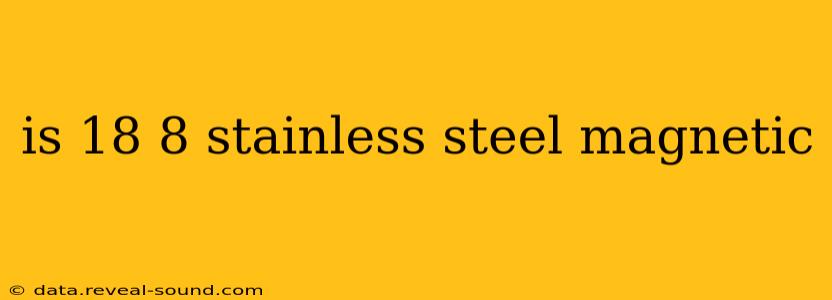The magnetism of 18/8 stainless steel, also known as Type 304 stainless steel, is a common question among consumers and professionals alike. The short answer is: sometimes. The magnetism depends on the processing and composition of the specific steel. Let's delve deeper into why this is the case.
What is 18/8 Stainless Steel?
18/8 stainless steel gets its name from its composition: approximately 18% chromium and 8% nickel. These elements are crucial for its corrosion resistance and strength. However, the exact percentages can vary slightly depending on the manufacturer and the intended application.
Why is Some 18/8 Stainless Steel Magnetic?
Austenitic stainless steels, like 18/8, are generally considered non-magnetic. This is because their crystalline structure, known as austenite, is non-magnetic. However, several factors can influence their magnetic properties:
-
Cold Working: Processes like bending, rolling, or stamping can introduce stresses within the metal's structure, causing a transformation of some of the austenite into a magnetic phase called martensite. This is particularly true for thinner sheets of 18/8 stainless steel. The more the steel is worked, the more likely it is to be magnetic.
-
Variations in Composition: Slight variations in the chromium and nickel content, even within the 18/8 range, can affect the steel's magnetic susceptibility. A slightly lower nickel content might lead to a greater tendency towards magnetism.
-
Manufacturing Processes: Inconsistent manufacturing processes can result in uneven distribution of elements, leading to localized magnetic properties.
-
Presence of Other Elements: Trace amounts of other elements in the steel alloy can influence magnetic properties.
Is My 18/8 Stainless Steel Magnetic? What Does This Mean?
If you find your 18/8 stainless steel to be slightly magnetic, it's not necessarily a cause for concern. A weak magnetic attraction usually indicates cold working during manufacturing. It doesn't necessarily mean the steel is inferior or less corrosion-resistant. However, a strongly magnetic piece of 18/8 stainless steel might indicate a problem in the manufacturing process or a different alloy altogether.
How Can I Test if My Stainless Steel is Magnetic?
A simple test involves using a strong magnet. Hold the magnet close to the stainless steel item. A slight attraction indicates some degree of magnetism, while no attraction suggests it's largely non-magnetic. Keep in mind, the strength of the magnet will influence the results; a weaker magnet might not detect slight magnetism.
What are the Differences Between Magnetic and Non-Magnetic 18/8 Stainless Steel?
The primary difference lies in the microstructure and magnetic susceptibility. A non-magnetic 18/8 stainless steel possesses a fully austenitic structure, while a magnetic one has undergone a transformation to martensite, either through cold working or compositional variations. Both types usually retain similar corrosion resistance and strength properties, although cold-worked steel might exhibit slightly altered mechanical properties.
Can I Use a Magnetic 18/8 Stainless Steel Item Safely?
Yes, generally speaking, a slightly magnetic 18/8 stainless steel item is still safe for its intended purpose. Its corrosion resistance and other properties shouldn't be significantly affected. However, if you have concerns about the specific application, it's advisable to contact the manufacturer for clarification.
What types of stainless steel are always non-magnetic?
While 18/8 stainless steel typically is non-magnetic, some austenitic stainless steels, like 304L, are designed to remain fully non-magnetic even under significant cold working. Other stainless steel grades, like ferritic and martensitic stainless steels, are inherently magnetic.
This information should clarify the magnetism of 18/8 stainless steel. Remember, slight magnetism doesn't automatically mean a defect; it’s often a result of the manufacturing process. However, if you have concerns, contacting the manufacturer is always a good idea.
